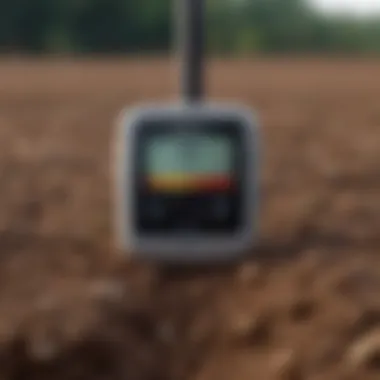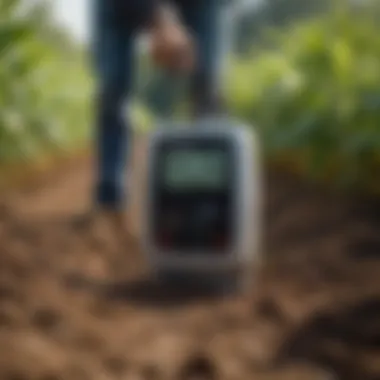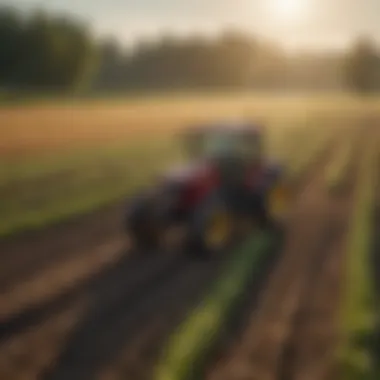The Hanna Meter: Precision Agriculture's Key Instrument


Intro
In the landscape of modern agriculture, precise measurement and monitoring of environmental factors has become crucial. The appreciation for tools that enable accurate data collection is rising. One such device is the Hanna Meter, which stands out for its ability to provide essential measurements for optimal plant development.
This article aims to shed light on the functionality and significance of the Hanna Meter in agricultural practices. Several key areas will be explored, including the influence of this device on soil management and nutrient monitoring, as well as its role in enhancing overall agricultural productivity. By understanding how the Hanna Meter integrates with sustainable farming practices, farmers and horticulturists can better navigate the demands of modern agriculture.
Moreover, we will discuss the latest technological advancements related to the Hanna Meter, offering insights into its future applications in agronomy and horticulture. This comprehensive guide will serve as a resource for those interested in improving their agricultural practices through precision measurement.
Preamble to the Hanna Meter
The Hanna Meter stands as a significant instrument in the realm of precision agriculture. In an era where data-driven decisions shape the future of farming, understanding and utilizing this tool is essential. The Hanna Meter allows farmers to accurately measure various soil and water parameters that are critical for optimal plant health and productivity. This guide delves into the various aspects of the Hanna Meter, underscoring its importance in modern agriculture practices.
Definition and Purpose
The Hanna Meter is a scientific instrument designed to measure specific characteristics of liquids and soils. These measurements include pH levels, electrical conductivity, and total dissolved solids, among others. The purpose of the Hanna Meter is to provide accurate and reliable data that farmers can use for making informed decisions regarding soil management, irrigation practices, and nutrient applications. With this information, farmers can address issues before they escalate and ensure that their crops are receiving the ideal conditions for growth.
Historical Context
The evolution of the Hanna Meter can be traced back to the late 20th century when advancements in analytical chemistry began to influence agricultural practices. Before this, more traditional methods of soil sampling and analysis were prone to inaccuracies and often left farmers uncertain about the health of their crops or soil. The introduction of portable and digital meters, primarily from Hanna Instruments, transformed the way agricultural data is collected. This transition from laboratory settings to field measurements marked a pivotal shift, allowing real-time feedback and immediate adjustments in farming techniques. As agriculture continues to move towards precision and sustainability, the Hanna Meter's relevance only grows.
"Data-driven farming strategies are essential for improving efficiency in agricultural production."
Understanding the historical context of the Hanna Meter helps in appreciating its current significance and the advancements seen in modern agriculture. The integration of such precision tools has not only improved crop yields but also supports sustainable practices that benefit the environment.
Different Types of Hanna Meters
The variety of Hanna Meters available underlines their essential role in precision agriculture. Each type of meter caters to specific measurement needs, addressing various aspects of agricultural practices. Understanding these different types is crucial for farmers and enthusiasts, as it allows them to choose the right tool for their particular requirements. This section will explore three primary types of Hanna Meters: pH Meters, EC Meters, and TDS Meters.
pH Meters
Hanna pH Meters are fundamental in agriculture, as soil and water pH levels can significantly affect plant growth and nutrient availability. The pH scale ranges from 0 to 14, where values below 7 signify acidic conditions and values above 7 indicate alkalinity.
A Hanna pH Meter allows for accurate measurement of these levels. Regular monitoring of soil pH can inform farmers about necessary amendments, such as the addition of lime or sulfur to balance acidity. Improved pH management helps in optimizing nutrient uptake, ultimately leading to healthier plants and better yields. For instance, certain crops, such as blueberries, thrive in acidic soils, while others prefer neutral or alkaline conditions. Knowing the right pH level can be the difference between a successful harvest and crop failure.
EC (Electrical Conductivity) Meters
EC Meters from Hanna are another vital tool in monitoring soil and water conductivity. Electrical conductivity measures the ability of a solution to conduct electricity, which correlates with the concentration of dissolved salts. This is particularly important in precision agriculture as it helps determine soil salinity, which can affect plant growth.
A Hanna EC Meter assists farmers in assessing soil salinity levels to prevent salt stress in crops. Excessive salinity can lead to poor water absorption and nutrient imbalances. By regularly measuring EC levels, farmers can make informed decisions on irrigation practices. These meters can guide them in adjusting fertilizer applications, ultimately improving both crop health and productivity.
TDS (Total Dissolved Solids) Meters
Total Dissolved Solids (TDS) refer to the combined content of all inorganic and organic substances contained in a liquid. TDS Meters from Hanna are essential for measuring the total concentration of dissolved solids in water, which plays a critical role in irrigation.
Using a Hanna TDS Meter facilitates the assessment of water quality. For instance, high TDS levels can indicate poor water quality, potentially harming crops. By monitoring TDS levels, farmers can ensure that irrigation water is suitable for their crops. This is especially important in areas where water quality can fluctuate. Managing TDS levels correctly helps in maintaining optimal growing conditions and improving overall yield.
How the Hanna Meter Works
Understanding how the Hanna Meter functions is essential for recognizing its role in precision agriculture. It operates as a sophisticated device that provides accurate measurements of various parameters such as pH, electrical conductivity, and total dissolved solids. These measurements enable farmers to make informed decisions about soil management, nutrient application, and irrigation practices.
Working Principle
The working principle of the Hanna Meter is rooted in the interaction between electrodes and the solutions being tested. Each type of meter comprises specialized sensors that respond to specific ions or properties of the soil or water sample. For instance, a pH meter uses a glass electrode that measures the hydrogen ion concentration in a solution.
When a sample is taken, the electrode pair generates an electrical signal based on the sample’s properties. This signal is then converted into a readable output, typically displayed on a digital screen. The accuracy of these readings is influenced by the composition of the sample and the condition of the electrodes, which are pre-programmed to provide precise calibrations based on standard solutions.


Calibration Procedures
Calibration of the Hanna Meter is a crucial step that ensures the accuracy and reliability of its measurements. This process involves adjusting the meter’s readings according to known reference standards.
- Preparation of Standard Solutions: The calibration requires standard solutions with known pH or conductivity values. These solutions are readily available and must be fresh for accurate results.
- Selecting the Right Mode: Before calibration, it is important to set the meter to the correct mode corresponding to the measurement type, whether it be pH, EC, or TDS.
- Performing Calibration:
- Post Calibration Checks: After calibration, it is prudent to check the meter with the standard solutions to confirm its accuracy before proceeding with actual testing.
- Immerse the electrode in the first standard solution.
- Allow the reading to stabilize.
- Confirm the reading by pressing the calibration button.
- Repeat the process with at least two more standard solutions for accuracy.
Calibrating the Hanna Meter regularly, particularly before significantly important measurements, is essential for achieving precise results and maintaining the integrity of agricultural practices.
"Regular calibration of measurement tools directly correlates with enhanced accuracy in agricultural outcomes."
By ensuring proper calibration, users can trust the data obtained, which ultimately leads to better farming decisions.
Applications in Agriculture
The application of the Hanna Meter in agriculture is essential for achieving optimal plant growth and sustainability. By utilizing precise measurements of various parameters, farmers can make informed decisions that directly impact their yields and the health of their crops. The relevance of the Hanna Meter extends to soil management, nutrient assessment, and maintaining water quality, making it a multifaceted tool in precision agriculture. Understanding these applications can lead to improved practices and better resource management.
Soil Testing and Management
Soil testing is vital for understanding the specific conditions of farmland. The Hanna Meter allows for accurate pH measurements, which are crucial for revealing the acidity or alkalinity of the soil. Such data helps farmers amend their soil effectively, ensuring that it supports the intended crops. Furthermore, by knowing the electrical conductivity (EC) through the Hanna Meter, farmers can gauge salinity levels in the soil. High salinity can inhibit plant growth, especially in sensitive crops. By monitoring these parameters, farmers can tailor their soil management practices, leading to healthier and more productive crops.
Incorporating Hanna Meter measurements into soil management strategies can lead to several benefits:
- Targeted Amendments: Adjustments in soil composition can be made based on specific needs identified through measurements.
- Consistency: Regular soil testing with the Hanna Meter allows for long-term tracking of soil health, ensuring that practices remain effective over time.
- Cost Efficiency: Improved understanding of soil needs can reduce unnecessary use of fertilizers and amendments, ultimately saving costs.
Nutrient Monitoring
Nutrient monitoring is another crucial function of the Hanna Meter, particularly in precision agriculture. Farmers must ensure that crops receive essential nutrients in the right amounts. The device can measure Total Dissolved Solids (TDS), which serves as an indicator of nutrient concentrations in irrigation water. The Hanna Meter provides real-time updates on nutrient levels, enabling farmers to quickly correct deficiencies or imbalances.
By using the Hanna Meter for nutrient monitoring, farmers can achieve:
- Enhanced Crop Performance: Efficient nutrient application leads to optimal growth and development of crops.
- Reduced Waste: Monitoring allows for precise application of fertilizers, minimizing waste and environmental impact.
- Healthier Plants: Proper nutrient balance promotes plant health, making them more resilient to diseases and pests.
Water Quality Assessment
Water quality is critical in agriculture, as irrigation water must be suitable for crops. The Hanna Meter assists in assessing several water quality parameters, including pH, TDS, and EC. This information is essential for ensuring that irrigation practices do not harm crop health. For instance, poor water quality can lead to nutrient deficiencies or toxicities, impacting crop yields.
Regular water quality assessment with the Hanna Meter offers several advantages:
- Informed Irrigation Practices: Farmers can adjust their irrigation methods based on water quality data, ensuring optimal crop health.
- Sustainable Practices: Understanding the interaction between soil and water quality leads to minimized environmental impacts.
- Regulatory Compliance: Adherence to standards for water quality can be monitored more effectively, preventing potential violations.
"Using a Hanna Meter helps bridge the gap between theory and practice in modern farming, ensuring that farmers operate in the best interest of their crops, environment, and the agriculture industry as a whole."
Benefits of Using a Hanna Meter
Understanding the benefits of using a Hanna Meter is crucial for anyone involved in precision agriculture. This device enhances measurement accuracy, which directly impacts crop management practices and overall farm productivity. Farmers can take better-informed decisions that lead to increased yields, improved sustainability, and responsible farming practices. Let's explore these benefits in more detail.
Enhanced Accuracy
Accuracy is perhaps the most significant advantage of utilizing a Hanna Meter. When measuring parameters such as pH, electrical conductivity, and total dissolved solids, these meters provide precise readings. This precision helps in identifying soil deficiencies or excesses that might not be accessible through traditional agricultural methods.
With regular calibration and maintenance, the Hanna Meter can maintain a high level of accuracy. This consistent performance allows farmers to monitor their fields effectively. Farmers can ensure that the conditions are optimal for plant growth.
"Accurate measurements can prevent crop failures and ensure healthy growth."


Improved Crop Yield
Another substantial benefit of using a Hanna Meter in agriculture is the potential for improved crop yield. When farmers apply the correct nutrients and manage soil conditions effectively, crops can thrive. The Hanna Meter facilitates this by providing data that informs nutrient management decisions.
For example, if soil pH is too low or too high, crops may struggle to absorb essential nutrients. Adjusting these levels based on precise measurements can therefore optimize nutrient uptake. Thus, accurate data from Hanna Meters can contribute to maximized yield, ultimately leading to improved economic viability for farmers.
Sustainability in Farming Practices
In recent years, sustainability has become a significant focus in agriculture. The use of a Hanna Meter contributes to this goal by promoting responsible resource management. By accurately assessing soil and water conditions, farmers can minimize the use of chemicals and fertilizers. This practice not only reduces costs but also lessens environmental impact.
Sustainable practices led by accurate data can also improve public perceptions of farming. Consumers are increasingly concerned about how their food is produced. Transparency in farming practices supported by tools like the Hanna Meter can help bolster a farmer's reputation.
In summary, the benefits of using a Hanna Meter extend beyond mere measurement. Enhanced accuracy, improved crop yields, and increased sustainability are critical elements that factor into modern farming practices. Understanding these benefits is essential for farmers looking to implement precision agriculture effectively.
Technological Advancements and Innovations
Technological advancements have profoundly influenced precision agriculture. As farmers seek to maximize productivity while minimizing resource use, innovations in measurement tools, particularly the Hanna Meter, become increasingly crucial. These developments facilitate accurate monitoring, helping to ensure that agricultural practices are both efficient and sustainable.
Digital Integration and User Interfaces
The evolution of digital technology has transformed the user experience of agricultural tools. The Hanna Meter exemplifies this trend with its user-friendly digital interfaces. Farmers can now interact with their devices in more intuitive ways, adjusting settings and interpreting data with ease.
Benefits of Digital Integration:
- Real-time Data Access: Continuous monitoring allows for immediate adjustments to farming practices based on current conditions.
- Improved Accuracy: Digital readings minimize human error, ensuring that data collected is reliable.
- User-friendly Features: Many meters now come equipped with customizable settings to suit individual user needs.
The shift towards digital interfaces does not only enhance user experience but also enables more extensive data collection. Farmers can analyze trends over time, leading to informed decision-making about their land.
Mobile Applications and Remote Monitoring
The growth of mobile technology dramatically enhances agricultural management. With mobile applications designed for Hanna Meters, farmers gain the flexibility to monitor their measurements from distant locations. This capability significantly improves agricultural efficiency.
Key Aspects of Mobile Monitoring:
- Convenience: Farmers can track soil and water quality metrics while on the go, freeing them from the constraints of close-range physical monitoring.
- Alert Systems: Many applications feature real-time alerts when measurements fall outside acceptable ranges, enabling immediate action.
- Data Synchronization: Remote monitoring provides the ability to sync data collected from different devices, offering a holistic view of farming operations.
Overall, the incorporation of mobile applications and remote monitoring not only simplifies the process but also promotes better management practices in agriculture. Farmers utilizing these technologies will likely see improvements in productivity and crop health.
Challenges and Limitations
Understanding the challenges and limitations of the Hanna Meter is vital for effective use in precision agriculture. While this tool offers numerous benefits, it is essential to recognize hurdles that may affect its adoption and performance in real-world scenarios. Two primary concerns stand out: the cost of technology and the necessity for user training.
Cost of Technology
The investment in a Hanna Meter can be significant, especially for small to medium-sized farms. The initial purchase price may deter some farmers from integrating this tool into their operations. Hanna Meters come in various models with different capabilities, and the more advanced models, which include features like digital integration, usually cost more. While these features can enhance precision and provide more data points, the financial barrier may exclude some users from accessing enhanced agricultural insights.
- Budget Considerations: Farmers need to assess the long-term benefits against the upfront costs. Evaluating potential yield improvements can justify the investment, but this analysis requires careful financial planning.
- Maintenance Costs: Regular calibration and maintenance of the equipment can add to its total cost over time. Farmers must factor in these ongoing expenses to understand the complete financial commitment.
- Access to Funding: Some farmers may not have easy access to funds or financing options to purchase advanced devices. Consequently, they might miss an opportunity to improve their farming practices through precision tools.
User Training and Knowledge Gaps
Another crucial limitation involves user training and knowledge gaps. Precision agriculture relies not just on having the right tools, but also on understanding how to use them effectively. The complexity of the Hanna Meter’s functionalities can pose a challenge for users who may not have a strong technical background.
- Training Programs: Without adequate training programs, farmers may struggle to maximize the device's capabilities. Understanding how to calibrate the meter, interpret the data, and apply it effectively in agricultural practices is critical for achieving optimal results.
- Knowledge Resources: Access to reliable resources, such as manuals or online tutorials, is essential for empowering farmers to use Hanna Meters confidently. If users do not have these resources, their ability to leverage the technology is compromised.
- Generational Knowledge Transfer: Many agricultural practices are passed down through generations. New technologies such as the Hanna Meter may not align with traditional methods, creating friction about adoption. Educating older farmers on the benefits and usage of these tools is crucial for successful integration.
"Addressing these challenges is essential. Without understanding the barriers, farmers cannot fully benefit from the precision agriculture revolution."


Case Studies and Real-world Applications
The application of Hanna Meters in precision agriculture is not just theoretical; there are many real-world scenarios demonstrating their value. These case studies provide practical insights into how farmers have successfully implemented these devices, making data-driven decisions that enhance productivity and sustainability.
Successful Implementation in Crop Management
Farmers face pressure to maximize yield while maintaining sustainable practices. Many are turning to Hanna Meters for solutions. A case in point is a large-scale corn farm in the Midwest United States. By employing Hanna pH and EC meters, this farm optimized soil conditions through precise measurements. They adjusted soil amendments based on the real-time data provided by the Hanna Meter, leading to a significant increase in crop yield.
The farmers noticed more consistent growth and healthier crops, which in turn reduced input costs for fertilizers and pesticides. This demonstrates how accurate soil management can contribute to economic savings and environmental benefits.
"Utilizing Hanna Meters has transformed our approach to crop management. The data allows us to make informed decisions that impact both yield and sustainability."
— Farm manager, Midwest Corn Producer
Impact on Horticultural Practices
In the realm of horticulture, the importance of accurate measurements cannot be overstated. A notable example involves a greenhouse specializing in organic tomatoes. The owner employed Hanna TDS meters to ensure optimal water quality. By analyzing the total dissolved solids, he tailored the irrigation system to deliver precisely what the plants needed, avoiding excess runoff and nutrient waste.
As a result, the tomatoes exhibited improved taste and shelf life, garnering higher prices in the market. This indicates that incorporating Hanna Meters not only enhances plant health but also positively impacts profitability. Furthermore, consistent monitoring ensures that organic certifications remain intact by adhering to stringent quality standards.
The result of these case studies highlights a crucial truth: the Hanna Meter is not merely a tool but an integral component of successful agricultural practices. This blend of technology and traditional farming methods is essential for modern agriculture.
Future Trends in Precision Agriculture
The landscape of precision agriculture is undergoing significant transformation. As farmers and agricultural professionals face new challenges, particularly from climate change and a growing global population, the adoption of advanced technologies is becoming increasingly important. Future trends outline how innovations, particularly in data management and machine learning, are set to reshape farming. These advancements aim to not only improve efficiency but also to ensure sustainability and resilience in agricultural practices.
The Role of Data Analytics
Data analytics is at the forefront of modern agriculture. It allows for the collection, processing, and interpretation of large sets of data, which can lead to improved decision-making. Farmers can gather data from various sources, including the Hanna Meter, to monitor soil conditions, crop health, and environmental factors.
Key benefits of data analytics in agriculture include:
- Enhanced Decision-Making: Farmers can make informed choices based on real-time data analysis, leading to better crop management.
- Predictive Insights: Analytics can help predict outcomes based on historical and current data, aiding in effective planning and resource allocation.
- Cost Efficiency: By understanding the precise needs of crops, farmers can optimize input usage, reducing waste and lowering costs.
Incorporating data analytics into agricultural practices introduces complexity but offers substantial rewards. The ability to analyze data trends opens avenues for identifying patterns that can enhance productivity.
Integration with AI and Machine Learning
The integration of artificial intelligence and machine learning into agriculture marks another significant trend. These technologies enhance the functionality of tools like the Hanna Meter by providing predictive capabilities and automation. AI can analyze data from the Hanna Meter rapidly, offering insights that might not be visible at first glance.
Considerations for integrating AI and machine learning include:
- Automated Monitoring: AI systems can monitor and adjust conditions automatically, ensuring that crops receive optimal nutrients continuously.
- Risk Assessment: Machine learning algorithms can assess risks related to pests, diseases, or environmental changes, enabling proactive measures.
- Customized Solutions: Utilizing these technologies creates tailored strategies for farming operations, improving overall effectiveness and yield.
In summary, the key trends shaping precision agriculture focus on data and technology. Embracing these advancements can lead to a significant enhancement in farming practices. They empower farmers with tools that help them adapt to the evolving landscape of agriculture efficiently.
Ending
The conclusion serves as a vital component, synthesizing the essential insights gleaned from the discussions surrounding the Hanna Meter in precision agriculture. Understanding the role of this tool is critical for anyone involved in farming or horticulture. The Hanna Meter stands out for its ability to provide accurate measurements of pH, electrical conductivity and total dissolved solids. Such parameters are not just numbers; they deeply influence soil health, water quality, and ultimately crop productivity.
Summary of Key Insights
The Hanna Meter proves its significance through various facets:
- Precision Measurement: The key feature of the Hanna Meter relies on its ability to provide precise and reliable measurements. This is crucial for determining soil and water quality.
- Diverse Applications: From soil management to nutrient monitoring, its applications are diverse, helping farmers achieve effective resource management.
- Technological Adaptation: The integration of digital tools and mobile applications enhances accessibility. This evolution in technology ensures that farmers can make informed decisions swiftly.
- Sustainability Focus: As agriculture faces increasing scrutiny for its environmental impact, tools like the Hanna Meter facilitate sustainable practices that optimize resource usage without compromising productivity.
Final Thoughts on the Hanna Meter's Impact
As agriculture pushes towards greater efficiency and environmental stewardship, the Hanna Meter emerges as a central tool. Its impact extends beyond merely measuring parameters; it transforms farming practices. With the ability to accurately assess critical data, farmers can make educated decisions, potentially leading to improved yields and sustainable practices. Moreover, as technology evolves, we can expect even more refined tools to enhance agricultural productivity and sustainability.
In summary, the Hanna Meter's role in precision agriculture is not just beneficial; it is essential for the future of efficient and responsible farming.















